Selected Writings: W.E.H. Stanner
Australia is not renowned for producing great thinkers. We do not usually care for such theorists, being fundamentally an active, practical folk. Thus it is a pleasant surprise to find a work that collates all the principal essays and talks of a man who has profoundly inspired not only a host of our public policies and research initiatives, but also much of our current understanding of what ‘Australia’ means.
READ REVIEW
↓
Selected Writings: W.E.H. Stanner
La Trobe University Press | 2024
William Edward Stanner (1905–1981) is mostly remembered as an anthropologist, but he was also (indeed, by occupation for quite a while) a journalist and an essayist. We can see the impact of the latter profession in his rich command of language.
Stanner left a huge imprint, especially on how white Australians today interact with First Nations people and their culture. If you appreciate Indigenous art, you can mostly thank Stanner for awakening the world to the beauty of Arnhem Land murals in the 1940s and 1950s (and encouraging the development of bark painting there). If you have ever used resources at the Australian Institute of Aboriginal and Torres Strait Islander Studies (AIATSIS), you can thank Stanner for conceptualising that institute. If you wondered who de-escalated the assimilation policy and drove the success of the 1967 Referendum that gave First Nations people voting status, again: thank Stanner. Even if you use the term ‘Dreamtime’ and have personally felt a spiritual connection to ‘the land’, you can probably thank Stanner for his powerful ‘Dreaming’ essay through which he somehow stirred the bulk of Australia to appreciate Spencer and Gillen’s ethnographic discoveries.
In other words, William Stanner is the living proof of the transformative power of the pen. He was indisputably one of the nation’s most important theorists. Yet even though many of us know the impact of his ‘After the Dreaming’ Boyer Lectures, his words have not always been easy to locate. Selected Writings – a re-issue of the Dreaming and Other Essays (2011) – assembles eleven of Stanner’s most important pieces. It includes a very useful index, and an equally helpful guide: Robert Manne’s introduction.
What I noticed in reading these essays is that Stanner was always ahead of his time. As early as 1938, he wrote that ‘tragedy underlies the rise of Australia’ (p. 123), and as early as 1958, he insisted that First Nations people ‘must be treated as individuals and not as groups’ (p. 148). That same year, he mocked the assimilation policy as colonial digestion: ‘the crunch with which the lion begins to assimilate the lamb’ (p. 154), and in 1963 (‘The History of Indifference Thus Begins’) he recognised that our methods of interacting with First Nations people were flawed from the start of First Settlement. Finally, pre-empting self-determination and the path to treaty, Stanner declared that we should always ‘use direct Aboriginal testimony to illuminate their problems with us, not ours with them’ (p. 246).
Today, such observations sound unremarkable, as does the casualness with which Stanner treated the warrior Durmugam as his equal. It is easy to forget that Stanner was saying all this many decades before other white Australians, despite growing up during the height of the White Australia policy and being himself trained in Australia and England on policies and academic theories that were deeply racist.
Selected Writings trumpets the triumph of Stanner’s non-judgmental outlooks over the views of his time. The book demonstrates his capacity to comment powerfully on what others wilfully ignored, for example, that we had given ‘no place in our past’ (p. 190) to Aboriginal people. The publication includes all of Stanner’s Boyer lectures, making it a very useful sourcebook for anyone working on Indigenous history or culture.
At first glance, this may seem heavy reading, but Stanner’s style is never convoluted or mysterious. Rather (in good Australian fashion) he tried to ‘tell it like it is’ – even when the topic was quite esoteric (e.g. Aboriginal spirituality) or heartbreaking (e.g. flawed policies). To end on a happy note, the last essay is Stanner’s piece on ‘Aboriginal Humour’. Even here, Stanner found something essential about Australian First Nations well before his peers.
Selected Writings: W.E.H. Stanner is published by La Trobe University Press.
Reviewer: Ray Kerkhove, PHA (Queensland), author of Aboriginal Campsites of Greater Brisbane, The Battle of One Tree Hill, and How They Fought.

